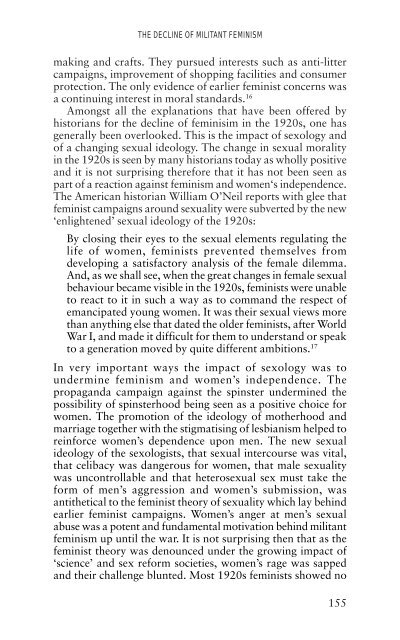The Spinster and Her Enemies - Feminish
The Spinster and Her Enemies - Feminish
The Spinster and Her Enemies - Feminish
Create successful ePaper yourself
Turn your PDF publications into a flip-book with our unique Google optimized e-Paper software.
THE DECLINE OF MILITANT FEMINISM<br />
making <strong>and</strong> crafts. <strong>The</strong>y pursued interests such as anti-litter<br />
campaigns, improvement of shopping facilities <strong>and</strong> consumer<br />
protection. <strong>The</strong> only evidence of earlier feminist concerns was<br />
a continuing interest in moral st<strong>and</strong>ards. 16<br />
Amongst all the explanations that have been offered by<br />
historians for the decline of feminisim in the 1920s, one has<br />
generally been overlooked. This is the impact of sexology <strong>and</strong><br />
of a changing sexual ideology. <strong>The</strong> change in sexual morality<br />
in the 1920s is seen by many historians today as wholly positive<br />
<strong>and</strong> it is not surprising therefore that it has not been seen as<br />
part of a reaction against feminism <strong>and</strong> women‘s independence.<br />
<strong>The</strong> American historian William O’Neil reports with glee that<br />
feminist campaigns around sexuality were subverted by the new<br />
‘enlightened’ sexual ideology of the 1920s:<br />
By closing their eyes to the sexual elements regulating the<br />
life of women, feminists prevented themselves from<br />
developing a satisfactory analysis of the female dilemma.<br />
And, as we shall see, when the great changes in female sexual<br />
behaviour became visible in the 1920s, feminists were unable<br />
to react to it in such a way as to comm<strong>and</strong> the respect of<br />
emancipated young women. It was their sexual views more<br />
than anything else that dated the older feminists, after World<br />
War I, <strong>and</strong> made it difficult for them to underst<strong>and</strong> or speak<br />
to a generation moved by quite different ambitions. 17<br />
In very important ways the impact of sexology was to<br />
undermine feminism <strong>and</strong> women’s independence. <strong>The</strong><br />
propag<strong>and</strong>a campaign against the spinster undermined the<br />
possibility of spinsterhood being seen as a positive choice for<br />
women. <strong>The</strong> promotion of the ideology of motherhood <strong>and</strong><br />
marriage together with the stigmatising of lesbianism helped to<br />
reinforce women’s dependence upon men. <strong>The</strong> new sexual<br />
ideology of the sexologists, that sexual intercourse was vital,<br />
that celibacy was dangerous for women, that male sexuality<br />
was uncontrollable <strong>and</strong> that heterosexual sex must take the<br />
form of men’s aggression <strong>and</strong> women’s submission, was<br />
antithetical to the feminist theory of sexuality which lay behind<br />
earlier feminist campaigns. Women’s anger at men’s sexual<br />
abuse was a potent <strong>and</strong> fundamental motivation behind militant<br />
feminism up until the war. It is not surprising then that as the<br />
feminist theory was denounced under the growing impact of<br />
‘science’ <strong>and</strong> sex reform societies, women’s rage was sapped<br />
<strong>and</strong> their challenge blunted. Most 1920s feminists showed no<br />
155

















